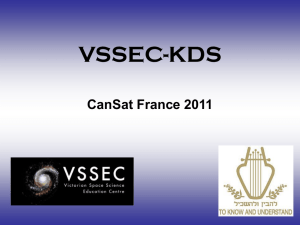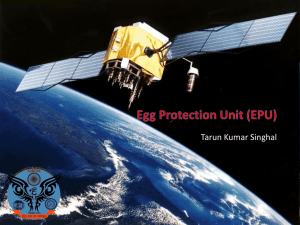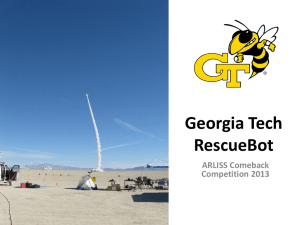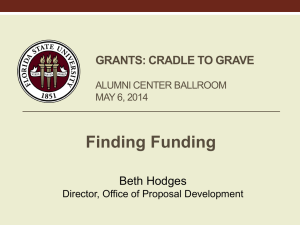02/01: Preliminary Design Review
advertisement
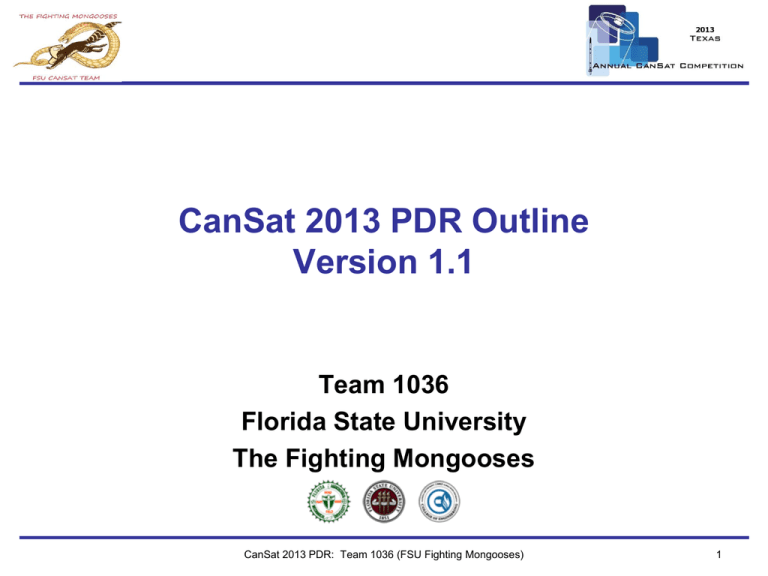
CanSat 2013 PDR Outline Version 1.1 Team 1036 Florida State University The Fighting Mongooses CanSat 2013 PDR: Team 1036 (FSU Fighting Mongooses) 1 Presentation Outline • • • • • • • • • • • Systems Overview………………………...Yasmin Belhaj Sensor Susbsystem Design……………...Samuel Rustan Descent Control Design…………………..Max Sandler, Andrew Grant Mechanical Subsystem Deign…..............Max Sandler Communication & Data Handling………..Andrew Guerr Electrical Power System Design…………Samuel Rustan Flight Software Design……………………Andrew Guerr Ground Control Control System Design...Andrew Guerr Cansat Integration and Test………………Andrew Grant, Samuel Rustan Mission Operation and Analysis…………Yasmin Belhaj Management…………………………...….Yasmin Belhaj, Samuel Rustan Presenter: Name goes here CanSat 2013 PDR: Team 1036 (FSU Fighting Mongooses) 2 Team Organization Name Yasmin Belhaj Andrew Grant Andrew Guerr Samuel Rustan Maxwell Sandler Presenter: Yasmin Belhaj Year Senior Senior Senior Senior Senior CanSat 2013 PDR: Team 1036 (FSU Fighting Mongooses) Discipline Mechanical Mechanical Computer Electrical Mechanical 3 Acronyms • • • • • • • • • • • • • • • • • • • A : Analysis ADC : Analog-to-Digital Converter ADR : Average Descent Rate ALD : Audible Locating Device API : Application Programming Interface CDP : Communications and Data Processing D : Demonstrable DCD : Descent Control Design DCS : Descent Control System DS : Datasheet EEPROM : Electrically Erasable Programmable Read-Only Memory EST : Estimate FIFO : First In, First Out FS : Flight Software GCS : Ground Control System I : Inspect I2C : Inter-Integrated Circuit I/O : Input/Output IDE : Integrated Development Environment Presenter: Samuel Rustan • • • • • • • • IV : Initial Velocity MMCX : Micro-Miniature Coaxial RSSI : Received Signal Strength Indication S/H : Shipping and Handling SSD: Sensor Subsystem Design SPI : Serial Peripheral Interface T : Test VM : Verification Matrix CanSat 2013 PDR: Team 1036 (FSU Fighting Mongooses) 4 Systems Overview Samuel Rustan CanSat 2013 PDR: Team 1036 (FSU Fighting Mongooses) 5 Mission Summary • Launch an autonomous CanSat with deployable payload containing a large hen egg • CanSat shall be deployed from Competition Rocket at approximately 670 [m], begin descent using a parachute and begin transmitting telemetry to ground station • At 400 [m] the container and payload will separate, safely landing using the parachute and aero-braking structure, respectively • Selectable Objective: Force of Impact Calculation – Upon impact of the payload an impact-force calculation shall be obtained and stored for post-flight analysis – The selection is based on the criteria of being a simpler sub-system to implement Presenter: Samuel Rustan CanSat 2013 PDR: Team 1036 (FSU Fighting Mongooses) 6 System Requirement Summary ID Requirement Rationale Priorit y Pare nt(s) Child(ren) VM A I X X SYS-01 Total mass of cansat shall not exceed 700 [g] (excluding egg) Base Mission Requirement High None MS-05, EPS-02 SYS-02 Cansat shall use a container to protect it from deployment from the competition rocket Base Mission Requirement High None MS-04 X SYS-03 Cansat shall use a descent and recovery system Base Mission Requirement Medium None DC-01,02,03, X SYS-04 Cansat shall comply with XBEE communication requirements Base Mission Requirement Medium None GCS-02,05 SYS-05 Cansat shall comply with electrical power requirements Base Mission Requirement High None DC-05, EPS01, EPS-07 X SYS-06 Cansat shall comply with the flight software requirements Base Mission Requirement Medium None FSW-01, 02, 04, 06 X SYS-07 Cansat flight hardware shall not exceed $1000 (USD) (Excluding Ground Support and analysis tools Base Mission Requirement Medium None None X SYS-08 Each team must use own ground control station (GCS) Base Mission Requirement High None FSW-07, GCS01-05 X Presenter: Samuel Rustan CanSat 2013 PDR: Team 1036 (FSU Fighting Mongooses) X T D X 7 System Requirement Summary ID Requirement Rationale Priority Parent(s) Child(ren) VM A I T D SYS-09 Cansat shall comply with structural requirements Base Mission Requirement High None DC-04, DC-01, MS-01, MS-05 X SYS-10 Cansat shall comply with mechanisms requirement Base Mission Requirement High None DC-04, DC-01, MS 03 X SYS-11 Cansat shall transmit telemetry data once every two seconds Base Mission Requirement High None MS-06, EPS-06 X SYS-12 Cansat shall measure the impact force with the ground Base Mission Requirement Medium None FSW-07 X Presenter: Samuel Rustan CanSat 2013 PDR: Team 1036 (FSU Fighting Mongooses) 8 System Level CanSat Configuration Trade & Selection • Egg compartment difficult to access if between electronics and separation mechanism • Adds failsafe protection to egg compartment utilizing the electronics as a hard cushion. • Egg compartment placed in the bottom section of the Payload. (Easy Access) • This system level configuration utilizes the trap door separation mechanism. (Not Applicable) Presenter: Max Sandler CanSat 2013 PDR: Team 1036 (FSU Fighting Mongooses) 9 System Level CanSat Configuration Trade & Selection Parachute Separation Mechanism Electronic Components • Egg compartment positioned low for easy access. • Separation concept chosen retains place at top of payload • Aero braking structure surrounds payload Aero-braking Structure Egg Compartment Presenter: Max Sandler CanSat 2013 PDR: Team 1036 (FSU Fighting Mongooses) 10 System Concept of Operations Final Check & Power On Integrate CanSat into Rocket Pre-Launch Preflight Briefing Launch CanSat Deployment & Initiate Telemetry Lander Separation & Deployment Ground Impact, End Telemetry Post-Launch CanSat Recovery Data Retrieval Post Flight Analysis Presenter: Samuel Rustan CanSat 2013 PDR: Team 1036 (FSU Fighting Mongooses) 11 System Concept of Operations CanSat Deployment (from Rocket) • • Container separates from rocket at approximately 670 [m] Container Air-braking Activated Payload Deployment (Separation) • • Ground Impact (Landing) • • Recovery • Payload separates from container at approximately 400 [m] Payload is deployed • Payload Air-braking Activated Presenter: Samuel Rustan Impact Force Calculation Audible Locator Activated • Container and Lander retrieved Impact Force Calculation obtained CanSat 2013 PDR: Team 1036 (FSU Fighting Mongooses) 12 Physical Layout – Launch Configuration Parachute Separation Mechanism Container Electronic Components Aero-braking Structure Payload Egg Compartment Presenter: Max Sandler CanSat 2013 PDR: Team 1036 (FSU Fighting Mongooses) 13 Physical Layout – CanSat Dimensions 50 mm Dimensions allow clearance in the given rocket section of 130 mm x 250 mm 45 mm 220 mm 100 mm 85 mm 120 mm Presenter: Max Sandler CanSat 2013 PDR: Team 1036 (FSU Fighting Mongooses) 14 Physical Layout – Deployed Configuration 375 mm Presenter: Max Sandler CanSat 2013 PDR: Team 1036 (FSU Fighting Mongooses) 15 Launch Vehicle Compatibility • The given length of the rocket compartment is said to be 250mm. The CanSat will be designed in order to give ample space for a smooth release. The designed Cansat length will be 220mm leaving 15mm of space on the top and bottom. • The given diameter of the rocket compartment is said to be 130mm. The designed CanSat diameter will be 120mm, leaving 5mm of space on both sides. • CanSat dimensions were chosen in order to give a comfortable fitment inside of the rocket compartment. • Spacious yet tight fit will ensure CanSat will not bounce around and reliable ejection. • Container of CanSat will will be a smooth, simple cylinder disallowing any protrusions to hinder ejection. Presenter: Max Sandler CanSat 2013 PDR: Team 1036 (FSU Fighting Mongooses) 16 Sensor Subsystem Design (SSD) Samuel Rustan CanSat 2013 PDR: Team 1036 (FSU Fighting Mongooses) 17 Sensor Subsystem Overview Sensor Type Model or Identification and Description Purpose CanSat Req. Pressure BMP-085, Barometric Pressure, Temperature, Altitude Sensor Non-GPS Altitude measurement Payload Temperature BMP-085 Temperature and Altitude Payload Accelerometer ADXL 326, triple axis sensing, ±16g output Base Mission Requirement Payload GPS 66-Channel, 10 Hz, Receiver, MTK339 Chipset Base Mission Requirement Payload Volt meter Arduino onboard ADC Base Mission Requirement Payload Presenter: Samuel Rustan CanSat 2013 PDR: Team 1036 (FSU Fighting Mongooses) 18 Sensor Subsystem Requirements VM ID Requirement Rationale Priority Parent Child A I SSD-01 Sensors must operate at 5 V or less. Arduino operates at 5 V Medium SYS-05 EPS-04 X SSD-02 Sensors must sample data at a rate of 1 [Hz] or higher Base Mission Requirement High SYS-11 None X SSD-03 Sensors shall use the following protocols: I2C, SPI, or Analog Interface to Microcontroller Medium SYS-06 None X SSD-04 Non-GPS Altimeter pressure sensor shall measure altitude with a precision of 0.5 [hPa] Base Mission Requirement High SYS-11 None X X SSD-05 Non-GPS Altimeter temperature sensor shall measure with a precision of 1 [ºC] Base Mission Requirement High SYS-11 None X X SSD-06 GPS sensor shall sample and transmit UTC time, latitude, longitude, mean sea level altitude, number of satellites tracked. Standard NEMA. Base Mission Requirement High SYS-11 None X X SSD-07 Accelerometer shall sample at a rate of at least 100 [Hz] Base Mission Requirement High SYS-12 None X X Presenter: Samuel Rustan CanSat 2013 PDR: Team 1036 (FSU Fighting Mongooses) T D 19 GPS Trade & Selection GPS Model Price [USD] Current [mA] MTK3339, 10 [Hz] 39.95 25 EM-406A, Sirf III 60.00 Tyco A1035-D, 5 [Hz] 62.00 Weight [grams] Accuracy [m] Start (Cold/Hot) Dimensions [mm] 8.5 2 34/2 25 x 35 x 7 44 16 10 42/8 31 x 31 x 10 41 15 10 35/1 36 x 36 x 8 GPS Module Selected: MTK3339 • Significantly lower weight • Significantly lower current (power draw) • Highly Accurate to 2 [m] • Antenna sensitivity to -165 [dB] • Fast Start time • Coding libraries available, widely used and tested Presenter: Samuel Rustan Photo courtesy of http://www.adafruit.com CanSat 2013 PDR: Team 1036 (FSU Fighting Mongooses) 20 Non-GPS Altitude Sensor Trade & Selection Model Price [USD] Mass [grams] Resolution [bits] Interface Protocol Sample Rate [Hz] Dimensions [mm] BMP-085 19.95 2 Pressure: 17 Temp: 16 I2C 2 17 x 17 x 2 MPL115A2 11.95 1 Pressure: 12 Temp: 11 I2C 1 10 x 15 x 2 SCP1000 29.95 2 Pressure: 17 Temp: 14 SPI 1-9 20 x 20 x 2 Altitude Sensor Selected: BMP-085 • • • • • • Significantly lower current (power draw) Pressure Accuracy to ± 0.2 [hPa] Temperature Accuracy to ± 0.5 [ºC] Altimeter accuracy of 0.25 [m] Ultra low current (power) Widely used and tested Photo courtesy of http://www.adafruit.com Presenter: Samuel Rustan CanSat 2013 PDR: Team 1036 (FSU Fighting Mongooses) 21 Air Temperature Trade & Selection • Air Temperature handled by the BMP-085 – Meets guidelines base mission requirements – Convenient since integrated on the same chip as the pressure/Altimeter sensor Presenter: Sam Rustan CanSat 2013 PDR: Team 1036 (FSU Fighting Mongooses) 22 Impact Force Sensor Trade & Selection Model Price [USD] Mass [grams] Current Draw [µA] Interface Protocol Sample Rate [Hz] Res. SIze [mm] ADXL 326 17.95 2 125 I2C, SPI 100 ±16g 19x19x3 LSM 303A 24.95 1 110 I2C, SPI 75 ±16g 3x5x1 ADXL 335 14.95 2 350 I2C, SPI 100 19x19x3 Accelerometer Selected: ADXL 326 • • • • Embedded FIFO, simplifies storage Ultra low current (power) Widely used and tested Included in same package as the pressure/altimeter sensor Photo courtesy of http://www.adafruit.com Presenter: Samuel Rustan CanSat 2013 PDR: Team 1036 (FSU Fighting Mongooses) 23 Descent Control Design (DC) Andrew Grant Max Sandler Yasmin Belhaj CanSat 2013 PDR: Team 1036 (FSU Fighting Mongooses) 24 Descent Control Overview • The descent is broken up into two phases. – Phase 1: Apogee to 400 m. – Phase 2: 400 m to impact. • For Phase 1 a parachute or streamer will be used. – It will be properly sized to meet the descent rate requirement of 20 m/s. • For Phase 2 a mechanism will activate to reduce the descent velocity to an acceptable impact velocity. Presenter: Yasmin Belhaj CanSat 2013 PDR: Team 1036 (FSU Fighting Mongooses) 25 Descent Control Requirements ID Requirement Rational Priority Parent(s) Child(ren) VM A I D T DC-01 The descent control system shall not use any flammable or pyrotechnic devices. Base Requirement High SYS-03, SYS-09, SYS-10 None X X DC-02 When above 400m the Cansat will be limited to 20 m/s by a passive descent control device Base Requirement Medium SYS-03 None X DC-03 Below 400m the Cansat will deploy an aero braking structure. Base Requirement High SYS-03 None X DC-04 All descent control devices and attachments must survive a 30g shock. Base Requirement High SYS-09, SYS-10 MS-01 X DC-05 The Cansat must have an 80 decibel audible locating device that will last for up to 3 hours. Base Requirement High SYS-05 None X Presenter: Yasmin Belhaj CanSat 2013 PDR: Team 1036 (FSU Fighting Mongooses) 26 Container Descent Control Strategy Selection and Trade Option 1: Round Parachute Pros: Drag coefficient 1.5 High stability, Compact Cons: High wind drift potential Option 2: Parasheet (Concept Selected) Pros: Simple, Compact, Drag Coefficient 0.75 Cons: High wind drift potential, less stable Option 3: Streamer Pros: Low Wind Drift Potential, Simple Cons: Drag Coefficient 0.14 – 0.4 Presenter: Andrew Grant CanSat 2013 PDR: Team 1036 (FSU Fighting Mongooses) 27 Payload Descent Control Strategy Selection and Trade Option 1: Spring Loaded Rods (Concept Selected) Torsional springs open rods/fabric fastened at base. Pros: Lightweight, Easy deployment Cons: Structural Integrity Option 2: Deployable Exterior Panels Rigid panels open using motor. Pros: Durable Cons: Weight, Power requirement Color: Blaze Orange Option 3: Telescoping Arms Fabric connected at center and tips will extend using linear actuator. Pros: Large area, Max drag Cons: Complex, Lengthy deployment time Presenter: Max Sandler CanSat 2013 PDR: Team 1036 (FSU Fighting Mongooses) 28 Descent Rate Estimates • Descent rates were estimated using a theoretical model built in Matlab using an iterative process. • Model designed behind the fundamentals of kinematics, Newtons Law of motion, and aerodynamic drag. • Assumptions - Constant drag coefficients - Interaction between container and parachute geometry, negligible - Estimated weight maximum allowable by rules Presenter: Max Sandler CanSat 2013 PDR: Team 1036 (FSU Fighting Mongooses) 29 Descent Rate Estimates Container & Payload Post Separation Matlab Output Screenshot Presenter: Max Sandler 30 CanSat 2013 PDR: Team 1036 (FSU Fighting Mongooses) Descent Rate Estimates Container after Separation from Payload Matlab Output Screenshot Presenter: Max Sandler 31 CanSat 2013 PDR: Team 1036 (FSU Fighting Mongooses) Descent Rate Estimates Payload after Separation from Container Matlab Output Screenshot Presenter: Max Sandler 32 CanSat 2013 PDR: Team 1036 (FSU Fighting Mongooses) Mechanical Subsystem Design Max Sandler Andrew Grant CanSat 2013 PDR: Team 1036 (FSU Fighting Mongooses) 33 Mechanical Subsystem Overview • Structure – The container and the payload structure will be made of molded polyethylene • Container/Payload Interface – The container will have hooks attached to hold the parachute and payload – The detachment mechanism will sit on top of the payload • Payload – The top portion of the payload will hold the electronics – The bottom portion of the payload will hold the egg and the batteries • Once the payload is being constructed the position of certain components may be changed to optimize the center of gravity Presenter: Andrew Grant CanSat 2013 PDR: Team 1036 (FSU Fighting Mongooses) 34 Mechanical Sub-System Requirements ID Requirement Rational Priority Parent(s) Child(ren) VM A I D T MS-01 Mechanisms must be capable of maintaining their configuration under all forces Base Requirement High SYS-10, DC04 None X X MS-02 Mechanisms must not use pyrotechnics or chemicals Base Requirement High DC-01 None X X MS-03 Mechanisms that use heat must not use be exposed to the environment Base Requirement High DC-01, SYS10 None X X MS-04 Mechanism must fit inside container Container must protect Payload High SYS-02 None X X MS-05 Total Mass of CanSat must be less than 700 [g] Rocket must be able to lift CanSat High SYS-01, SYS-09 None MS-06 Use of metal components shall be limited Limit Radio interference Medium SYS-11 None Presenter: Max Sandler CanSat 2013 PDR: Team 1036 (FSU Fighting Mongooses) X X X 35 Egg Protection Trade & Selection Material Density Cost Details Pros Cons Memory Foam 48-80 kg/m^3 $20-150/ mattress topper Rectangular foam 1.5 in thick Soft, light Susceptible to heat Dough unknown $2-10 Organic material with air pockets cheap Difficult to obtain consistent properties Polystyrene Beads 10501120 kg/m^3 12-15¢/ liter Expanded soft beads Cheap, light May get loose in container • Polystyrene Beads were selected. • Air between beads will lower density. • Inexpensive. • Best performance in experiment. Presenter: Max Sandler CanSat 2013 PDR: Team 1036 (FSU Fighting Mongooses) 36 Mechanical Layout of Components Trade & Selection • Structural materials will be made from selected Polyethylene. • Container, Payload envelope, and Payload compartments will all be formed from this same material by melting them together or creating small brackets in order to make manufacturing easier. • Egg Compartment will be placed on the bottom for ease of axis. • Ring release separation mechanism placed on top of payload in order to connect to eye bolt from container. • Phase 2 Aero Braking mechanism will encapsulate payload until deployment Presenter: Max Sandler CanSat 2013 PDR: Team 1036 (FSU Fighting Mongooses) 37 Material Selections Material Cost ($/m^2) Tensile Strength Density (MPa) (kg/m^3) Polyethylene 12.20-47.94 41.2 1040 light, strong, cheap, weaker then easily molded other options Fiber Glass 20-40/gal 42.3 1120 Light Strong difficult to use Carbon Fiber 300-500 3500 1330 Aluminum 69.00-144.77 152-310 light, strong strong, relatively cheap expensive heavier then other choices, 2700 Pros Cons Material Chosen: Polyethylene • Light • Strong Enough • Easily molded Presenter: Andrew Grant CanSat 2013 PDR: Team 1036 (FSU Fighting Mongooses) 38 Container - Payload Interface • Container • • • • DC Motor Motor Bracket Open Ring Eye Bolt • Payload Presenter: Maxwell Sandler CanSat 2013 PDR: Team 1036 (FSU Fighting Mongooses) 39 Structure Survivability Trades • For both Container and Payload discuss: – Electronic component mounting methods • Use stand-off screws for circuit boards and platforms within the interior of the payload for the electronics enclosure • All components will be connected via soldered connections – Unless cable or wire is secured by harness or clamp-connector – Acceleration and shock force requirements and testing • Based off material selection – Securing electrical connections. – Solder connections • Unless solderless, compression connections suffice • Electronics PCB held in place with glue Presenter: Maxwell Sandler CanSat 2013 PDR: Team 1036 (FSU Fighting Mongooses) 40 Mass Budget Payload Container Component Mass [g] Source Component Mass [g] Source Exterior Frame 61 Estimate Exterior Frame 130 Estimate Separation Component (lower) 20 Estimate Parachute 80 Estimate XBEE 5 Datasheet Estimate 6 Estimate Separation component (upper) 20 Antennae ADXL326 2 Datasheet Container Total 230 BMP085 2 Datasheet GPS 10 Datasheet Arduino Uno 20 Estimate 6 Datasheet Motor 10 Estimate Egg protection material 30 Estimate Battery 20 Datasheet Payload Total 208 Buzzer AI-2429-TWT-R Presenter: Andrew Grant Total Mass Estimate = 438 [g] CanSat 2013 PDR: Team 1036 (FSU Fighting Mongooses) 41 Communication and Data Handling (CDH) Subsystem Design Andrew Guerr Samuel Rustan CanSat 2013 PDR: Team 1036 (FSU Fighting Mongooses) 42 CDH Overview • Data from the GPS, altimeter, voltage divider, and accelerometer is received and processed by the Arduino Uno • Data from the sensors is put into a telemetry data packet by the FSW and transmitted to the GCS by the XBEE-Pro series 1 transciever Presenter: Andrew Guerr CanSat 2013 PDR: Team 1036 (FSU Fighting Mongooses) 43 CDH Requirements ID Requirement Rationale CDH-01 Microcontroller shall be capable of interfacing with all components. Microcontroller must take data from and control all other components CDH-02 Microcontroller shall operate at a high enough frequency to gather sensor data and output telemetry at 0.5 HZ Telemetry data must be sent every 2 seconds CDH-03 Communications radio shall be XBEE Series 1 or 2 Competition requirement CDH-04 XBEE radios shall have NETID set to the team number Competition requirement CDH-05 XBEE radio shall not use broadcast mode Competition requirement CDH-06 XBEE radio shall have minimum range of at least 1.4 km Radio must stay in contact throughout the flight CDH-07 ALD shall be rated above 80 dB Competition requirement ALD shall operate for at least 3 hours Competition requirement Presenter: Andrew Guerr CanSat 2013 PDR: Team 1036 (FSU Fighting Mongooses) 44 Processor & Memory Trade & Selection Memory Communication Operating Interfaces Voltage [V] Microcontroller Clock Speed [MHz] Arduino Uno 16 32k Arduino Pro Mini 328 16 16k FEZ Cerberus 168 300k Size Cost [$US] Serial, I2C, SPI, A2D Serial, SPI, I2C, A2D 5 2.7 x 2.1 in 30 5 0.7 x 1.3 in 19 SPI, I2C, 2xUART, A2D 5 2.25 x 1.85 in 30 Microcontroller Selection – Arduino Uno • Capable of interfacing with all needed components. • Good community support. • Existing libraries and simple development environment make it easy to develop for. Presenter: Andrew Guerr CanSat 2013 PDR: Team 1036 (FSU Fighting Mongooses) 45 Antenna Trade & Selection • Antenna compatible with XBEE – For integration onto CanSat, mobility is priority • ¼ wave monopole antenna • ½ wave dipole – Currently testing with A24-HASM 450 • Selected CanSat XBEE “on module” whip antenna • This antenna is designed specifically for the XBEE module • Placement of antenna can be moved off the module by u.FL cable Photo source: www.sparkfun.com Presenter: Samuel Rustan CanSat 2013 PDR: Team 1036 (FSU Fighting Mongooses) 46 Radio Configuration • Mission Guidelines stipulate the use of XBEE series 1 or 2 – XBEE modules shall not operate in the “Broadcast” mode • Direct Transmission in “Unicast Mode” will be utilized – This will reduce the chance of interference with other modules • To setup the XBEE, the X-CTU software is used – Set the PAN ID (4 digit hex) – Set Baud rate (57600 bps) • Transmission Control via API mode (Data Structure) – Start delimiter, data length bytes, API identifier, API frame ID, destination address, telemetry data, checksum Presenter: Samuel Rustan CanSat 2013 PDR: Team 1036 (FSU Fighting Mongooses) 47 Telemetry Format • Data included in transmissions: – From GPS: Local time, latitude, longitude, altitude, number of satellites tracked – From altitude sensor: altitude, temperature – From voltage divider: Battery voltage – From software: Team ID, software state • 75 characters sent every 2 seconds • Data rate 300 bps • Data will be sent in ASCII format Presenter: Andrew Guerr CanSat 2013 PDR: Team 1036 (FSU Fighting Mongooses) 48 Telemetry Format Data format CANSAT,<TEAM_ID>,<MISSION_TIME>,<GPS_TIME>,<GPS_LAT>,<GPS_LONG>,<GPS_ ALT>,<GPS_SAT>,<ALT_SENSOR>,<TEMP>,<BAT_V>,<STATE> Field Format Description <TEAM_ID> XXXX Assigned team id <MISSION_TIME> SSSSS Software mission time in seconds <GPS_TIME> HH:MM:SS GPS local time <GPS_LAT> DDMM.mmmmN GPS latitude <GPS_LONG> DDDMMM.mmmW GPS longitude <GPS_ALT> AAA.A GPS altitude in meters <GPS_SAT> XX GPS satellites tracked <ALT_SENSOR> AAA.A Non GPS altimeter altitude in meters <TEMP> TT Air temperature in degrees C <BAT_V> VV.V Battery voltage <STATE> X State of flight software Presenter: Andrew Guerr CanSat 2013 PDR: Team 1036 (FSU Fighting Mongooses) 49 Activation of Telemetry Transmissions • The flight software will run a loop checking for the command to begin telemetry transmissions and will do nothing until it is received. • The command to begin telemetry will be sent through the radio from the ground station. Presenter: Andrew Guerr CanSat 2013 PDR: Team 1036 (FSU Fighting Mongooses) 50 Audible Locating Device Trade & Selection Part Price Loudness Size (mm) (dB) Weight (g) Power Req. AI-2429-TWT-R $4.73 100 23.8 Dia x 16 H 6 8 mA 3-20 VDC AI-3035-TWT-3V-R $3.55 100 30 Dia x 20.5 H 10 9 mA 2-5 VDC AI-4228-TWT-R 42 Dia x 14 H 12 10 mA 3-28 VDC $4.54 99 • AI-2429-TWT-R chosen – Small size and weight and fulfills all requirements. • Enabling/Disabling – ALD will be activated when altitude has become constant. – Can be turned off by using external power switch. Presenter: Samuel Rustan CanSat 2013 PDR: Team 1036 (FSU Fighting Mongooses) 51 Electrical Power Subsystem (EPS) Design Samuel Rustan CanSat 2013 PDR: Team 1036 (FSU Fighting Mongooses) 52 EPS Overview Part Purpose Li-Ion Battery Stores all energy for all electrical devices Switch SPDT Controls power from battery to main circuitry Indicator LED Indicates “power on” state of CanSat Voltmeter Indicates battery state (via ADC of Arduino) Presenter: Samuel Rustan CanSat 2013 PDR: Team 1036 (FSU Fighting Mongooses) 53 EPS Requirements VM ID Requirement Rationale Priority Parent Child A I EPS-01 Battery shall provide at least 5 [V] output for duration of flight Arduino & sensors operate at 5 V Medium SYS-05 None X EPS-02 Battery mass/weight shall be less than 100 [g] Per the overall mass limitation Low SYS-01, MS-01 None X EPS-03 Battery shall be stored in Payload section of CanSat All electronics operate from payload Low None None X EPS-04 Voltage measurement shall draw negligible current Minimize energy loss Medium None None X EPS-05 Battery shall supply at least 2 times the expected energy use To ensure power is supplied for duration of flight and recovery Medium None None X EPS-06 Voltage measurement shall be integrated Base Mission Requirement High SYS-11 None X EPS-07 On/Off switch with external power indicator shall be accessible from the exterior of Container Base Mission Requirement High SYS-05 Presenter: Samuel Rustan CanSat 2013 PDR: Team 1036 (FSU Fighting Mongooses) T D X 54 Electrical Block Diagram GPS 5 V ON/OFF Arduino Uno 5V (onboard regulation) BMP085 5 V Battery 6 V XBEE 5 V Motor Buzzer 5 V Presenter: Samuel Rustan CanSat 2013 PDR: Team 1036 (FSU Fighting Mongooses) 55 Power Budget Component Voltage [V] Current [mA] Power [mW] Duty Cycle [min.] Energy [mWh] Arduino 5 50 250 10 42 I/O pns 5 40 200 10 33 GPS 3.3 25 82.5 10 14 BMP085 3.3 0.1 0.33 10 0 ADXL326 3.3 0.1 .33 10 0 XBEE Tx 3.3 250 825 6 83 XBEE Rx 3.3 55 181.5 6 18 Motor* 5 300 1500 1 25 Buzzer 5 8 40 180 120 Total 334 Available 750 * Denotes estimates, further work needed Presenter: Samuel Rustan CanSat 2013 PDR: Team 1036 (FSU Fighting Mongooses) 56 Power Source Trade & Selection Price [USD] Part Li-Ion Camera 6 [V], 2CR5MPA/B 7 Voltage [V] 6 Material Li Capacity [mAh] 1400 Mass [g] 38 Size [mm] 34 x 17 x 45 Battery Chosen: 2CR – 5MPA/B • • • • More than adequate capacity Provides enough voltage for 5 V system Small package, connections Continuous load current of 20 [mA] Photo source: www.digikey.com Presenter: Samuel Rustan CanSat 2013 PDR: Team 1036 (FSU Fighting Mongooses) 57 Battery Voltage Measurement Trade & Selection • Arduino onboard ADC used to measure voltage – Resolution of 10 bits • Simple voltage divider to ensure 3 V max, then voltage is measured based on schematic shown Presenter: Samuel Rustan CanSat 2013 PDR: Team 1036 (FSU Fighting Mongooses) 58 Flight Software (FSW) Design Andrew Guerr CanSat 2013 PDR: Team 1036 (FSU Fighting Mongooses) 59 FSW Overview • Will be programmed in C/C++ with Arduino IDE. • Flight software: – Monitors mission time and altitude. – Will release parachute and deploy – Reads sensors, builds data string, and transmits telemetry to ground station. Presenter: Andrew Guerr CanSat 2013 PDR: Team 1036 (FSU Fighting Mongooses) 60 FSW Requirements ID Requirement Rationale Priority Parent Child A I T FSW-01 FSW shall maintain and telemeter an indicator of the software state Base Mission Requirement High SYS-06 None X X X FSW-02 FSW shall be able to determine the correct state in the event of a processor reset Base Mission Requirement High SYS-06 None X X X FSW-03 FSW shall maintain total mission time in integer seconds Base Mission Requirement High SYS-06 None X X X FSW-04 FSW shall read sensors and transmit telemetry data packets at a rate of 0.5Hz Competition requires telemetry packets every 2 seconds High SYS-06 None X X FSW-05 FSW shall monitor altitude and deploy aero-braking structure when cansat goes below 400 m So aero-braking structure will be deployed at the proper altitude High SYS-03 None X FSW-06 FSW shall begin telemetry transmissions only when given the signal by the ground station Base Mission Requirement High SYS-06, SYS-11, SYS-08 None X FSW-07 FSW shall capture cansat’s impact force with the ground Selectable objective requirement High SYS-08 None Presenter: Andrew Guerr CanSat 2013 PDR: Team 1036 (FSU Fighting Mongooses) X X 61 D CanSat FSW State Diagram Presenter: Andrew Guerr Flight Software State Description 0 1 2 3 4 5 Software Initialization Launch Pad Ascending Descending to 400m 400m to Landing Landed CanSat 2013 PDR: Team 1036 (FSU Fighting Mongooses) 62 Software Development Plan • Early FSW prototypes have been coded using the Arduino IDE and an Arduino simulator. • Support for the radio transceivers will be coded first so that the Arduino can communicate, sensors will be coded for and integrated into the system as they are received. • The code will be tested as each sensor is integrated into the program. • Simulations will be run to approximate the conditions of the flight and possible problems to ensure the software will run properly under all conditions. Presenter: Andrew Guerr CanSat 2013 PDR: Team 1036 (FSU Fighting Mongooses) 63 Ground Control System (GCS) Design Andrew Guerr Samuel Rustan CanSat 2013 PDR: Team 1036 (FSU Fighting Mongooses) 64 GCS Overview Antenna Presenter: Andrew Guerr XBEE-Pro Series 1 XBEE Explorer CanSat 2013 PDR: Team 1036 (FSU Fighting Mongooses) Computer 65 GCS Requirements ID Requirement Rationale Priority Parent Child VM A I GCS-01 GCS antenna shall be elevated a minimum of 3.5 m Base Mission Requirement High None None GCS-02 GCS shall receive telemetry from the CanSat during flight GCS must receive telemetry for display and storage High SYS-11, SYS-94 None GCS-03 GCS shall display and graph telemetry in real time Base Mission Requirement High SYS-11 None GCS-04 GCS shall store telemetry data in a .csv file Base Mission Requirement High None None GCS-05 GCS shall send signal to CanSat to begin telemetry transmissions Base Mission Requirement High None None Presenter: Andrew Guerr CanSat 2013 PDR: Team 1036 (FSU Fighting Mongooses) T D 66 GCS Antenna Trade & Selection Antenna Price [$] Type Gain [dBi] ANT-DB1-VDP 9 Omni-Directional 0 A24-HASM-450 5 Dipole ½ wave 2.1 • Antenna Selected: A24-HASM-450 – Provides gain that will aid in maintaining link – Antenna mast height and mounting strategy • Launch day construction Photo source: www.matlog.com – Placed in proper competition area – Simply attach antenna to mounting bracket of extendable tripod – Height verified by tape measure of section lengths – Distance link predictions and margins • Expected range of 1.5 [km] Presenter: Samuel Rustan CanSat 2013 PDR: Team 1036 (FSU Fighting Mongooses) 67 GCS Software • Telemetry display prototypes • Commercial off the shelf (COTS) software packages used • Real-time plotting software design • Data archiving and retrieval approach • Command software and interface • Telemetry data recording and media presentation to judges for inspection Presenter: Andrew Guerr CanSat 2013 PDR: Team 1036 (FSU Fighting Mongooses) 68 CanSat Integration and Test Samuel Rustan Max Sandler CanSat 2013 PDR: Team 1036 (FSU Fighting Mongooses) 69 CanSat Integration and Test Overview • Mechanical – Parachute Attachment and Deployment • A large oatmeal can is about the size of the CanSat and can easily be made the same allowable mass as the final product. • Since there will certainly be excess plastic, a prototype attachment mechanisms can be made and attached to the oatmeal can. • A test of the parachute deployment can be tested by dropping the can from safe location at a parking garage with similar exiting conditions to the rocket and an ideal packing formation can be determined. – Structural Integrity • The structural integrity of the Payload can be determined by building a prototype and adding material to the inside to increase its mass to the proper amount. • Then, it can be dropped from a height where it will hit the ground the expected velocity. • If it passes that test, it can then be dropped from a height where it reaches a higher speed than intended for the worst case scenario. Presenter: Max Sandler CanSat 2013 PDR: Team 1036 (FSU Fighting Mongooses) 70 CanSat Integration and Test Overview – Detachment Mechanism • The attachment mechanism can be tested using a dragon board under static loading conditions similar to the CanSat falling at terminal velocity. • Then, its structural integrity will need to be tested under shock force conditions to ensure that it can withstand the force when the parachute opens. – Egg Protection • The egg protection device can be tested at the same time as the structural integrity test. • A prototype can be made and mounted inside the prototype payload. • If the egg survives the fall at the expected speed test, then it can also be tested under the worst case scenario condition as well. • If the prototype becomes dislodged during the test then, an new mounting method can determined – Aero-Braking Mechanism • A prototype aero-braking mechanism’s deployment should be tested first to ensure that the mechanism will open properly for a test with realistic conditions. • A wind tunnel could be used to test the mechanism under shock conditions. Presenter: Max Sandler CanSat 2013 PDR: Team 1036 (FSU Fighting Mongooses) 71 CanSat Integration and Test Overview – Aero-Braking Mechanism cont. • Proper measures would need to be taken to ensure that the test apparatus does not get sucked into the fan blades. • If the mechanism fails then, a new configuration with better support will need to be design or stronger material will need to be obtained. • It may me more simple to attach a weight to the bottom of the mechanism with a rope or cable and support the arms of mechanism with a flat surface, like a table, and drop the weight to simulate the shock force. Presenter: Max Sandler CanSat 2013 PDR: Team 1036 (FSU Fighting Mongooses) 72 CanSat Integration and Test Overview • Power/Electrical – All subsystems must be tested for expected behavior – EPS can be tested once the sensor subsystem is integrated with the microcontroller • Battery life analysis can be conducted using actual tested values • Communications – Primary integration concern – To ensure proper protocol and antenna selection, the CanSat and GCS must maintain constant communication for the entire duration • Tests will be done at minimum range of 1.5 [km] Presenter: Sam Rustan CanSat 2013 PDR: Team 1036 (FSU Fighting Mongooses) 73 CanSat Integration and Test Overview • • • Sensors – Pressure: • Will test and contrast to known altitudes • Test behavior communicating to microcontroller and XBEE – Accelerometer: • Sensor will be sampling at high rate for this device • Low priority: Product has been well tested and verified by multiple sources, though integration into CanSat system still unknown – GPS: • Predictions based of readings will require extensive testing – Voltmeter • Percent calculations and transmission will require some testing Flight Software – Some preliminary beta testing already completed – Further tests with actual components will be next Ground Control – Extensive testing will be required, since it is in an undeveloped (pre-alpha) stage Presenter: Sam Rustan CanSat 2013 PDR: Team 1036 (FSU Fighting Mongooses) 74 Mission Operations & Analysis Yasmin Belhaj CanSat 2013 PDR: Team 1036 (FSU Fighting Mongooses) 75 Overview of Mission Sequence of Events Arrival at Launch Site • • • Unpack and arrange GSC and Cansat Measure wind speed, environmental conditions Make final checks on Cansat Pre-Launch Checks • • • • Subsystems Check Configure Ground Station Configure and Confirm Sensor subsystem Confirm Mechanical Subsystems Integrate Cansat into Rocket • • • • Place Egg into Payload Place Payload into Container Power on Cansat Integrate Cansat into Rocket Presenter: Yasmin Belhaj CanSat 2013 PDR: Team 1036 (FSU Fighting Mongooses) 76 Overview of Mission Sequence of Events Launch Rocket • • Begin GCS and Cansat communications Begin Telemetry Phase1: Deployment • • Container parachute deployment Telemetry Data plotted Phase 2: Payload Separation and Descent • • At 400 [m] separation mechanism initiated Deployment of Payload airbraking system Phase 3: Payload Impact • • Impact Force calculated and stored Audible beacon activates CanSat 2013 PDR: Team 1036 (FSU Fighting Mongooses) 77 Overview of Mission Sequence of Events Recovery • • • Analysis Post Flight Review • Recover Container using the color of the container to aid in recovery Recover Payload using the buzzer Confirm that no part is left in the field • • Retrieve data from Payload via serial connection to Payload microcontroller Inspect Payload contents Analyze telemetry data • • Finalize PFR presentation and report results of flight Give presentation to competition attendees CanSat 2013 PDR: Team 1036 (FSU Fighting Mongooses) 78 Mission Operations Manual Development Plan • CanSat shall have finalized operation manual including – Documentation (from Fall semester) for CanSat design currently being revised – Revised design documentation (still under development) – Operating instructions • Cansat Competition Team manual shall include – Operations Manual – Competition program schedule Presenter: Yasmin Belhaj CanSat 2013 PDR: Team 1036 (FSU Fighting Mongooses) 79 CanSat Location and Recovery • Container will be easily noticeable due to weatherproof fluorescent paint. Parachute will also be chosen with a bright color. No audible beacon will be placed on the container. The use of binoculars will aid in the tracking of the container. • The payload will also be coated in a weatherproof fluorescent paint. As well, mandated by the competition rules, an audible beacon will also be activated upon launch and remain on in order to give ample time to locate. Binoculars may also be used in order to aid in the retrieval of the payload. Gathered GPS data sent to the ground station will also be used in retrieval Presenter: Yasmin Belhaj CanSat 2013 PDR: Team 1036 (FSU Fighting Mongooses) 80 Management Yasmin Belhaj Andrew Grant CanSat 2013 PDR: Team 1036 (FSU Fighting Mongooses) 81 CanSat Budget – Hardware Category Model Quantity Unit Price Price Price Definition ADXL326 1 18 18 Purchased GPS Module MTK3339 Altimeter/Pres/T emp BMP085 1 40 40 Purchased 1 20 20 Arduino Uno R3 Atmel 328 1 30 30 Purchased XBEE S1 Pro 2 32 64 Purchased CanSat Antenna N/A Ground Control Antenna 1 5 5 Purchased 1 60 60 Parachute 1 10 10 Estimated Capsule Materials polyethylene 1 36.48 36.48 Estimated Egg Protection 1 15 15 Estimated N/A N/A 30 Estimated Accelerometer XBEE 802.15.4 Misc. Mechanical N/A Estimated 328.50 Total Presenter: Andrew Grant Purchased CanSat 2013 PDR: Team 1036 (FSU Fighting Mongooses) 82 CanSat Budget – Other Costs Category Model Quantity Unit Price Price Price Definition Travel N/A 1 800 800 Estimated Hotel Shipping and Handling N/A N/A 1 624 624 Estimated Experiment N/A Estimated 1 100 100 N/A 16.42 16.42 1798.90 Total Cost Actual Estimated Income Sponsor Name ECE Department Private Donation Dr. Shih State Farm Total Funding Presenter: Andrew Grant Funds Received 200 750 1000 250 2200 CanSat 2013 PDR: Team 1036 (FSU Fighting Mongooses) Funds Pending 0 0 0 0 0 83 Program Schedule Presenter: Yasmin Belhaj CanSat 2013 PDR: Team 1036 (FSU Fighting Mongooses) 84 Conclusions • Presentation summary and conclusions • In general include the following: – Major accomplishments • Team collaboration & Concept Generation • Egg protection tests completed • Flight Software shell completed and tested with simulated components – Major unfinished work • Motor selection for separation mechanism still needs trade and selection Presenter: Yasmin Belhaj CanSat 2013 PDR: Team 1036 (FSU Fighting Mongooses) 85
